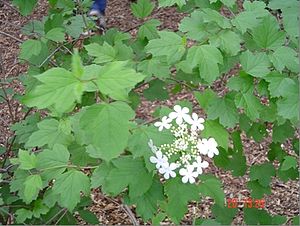Difference between revisions of "Viburnum trilobum"
Jump to navigation
Jump to search
m (1 revision: From PNW foraging book - part 2) |
(cut down) |
||
| Line 8: | Line 8: | ||
}} | }} | ||
| − | ''' | + | '''Cranberrybush viburnum''', '''American cranberrybush''', or '''high bush cranberry''' |
| − | |||
| − | |||
| − | + | [[Category:Adoxaceae]] | |
| − | + | [[Category:Plants for Keenan to eat]] | |
| − | |||
| − | |||
| − | |||
| − | |||
| − | |||
| − | |||
| − | |||
| − | |||
| − | |||
| − | |||
| − | |||
| − | |||
| − | |||
| − | |||
| − | |||
| − | |||
| − | |||
| − | |||
| − | |||
| − | |||
| − | |||
| − | |||
| − | |||
| − | |||
| − | |||
| − | |||
| − | |||
| − | |||
| − | |||
| − | [[Category: | ||
| − | [[Category:Plants | ||
| − | |||
Latest revision as of 20:20, 13 September 2018
| Viburnum trilobum | |
|---|---|

| |
| Scientific classification | |
| Kingdom: | Plantae |
| Clade: | Angiosperms |
| Clade: | Eudicots |
| Clade: | Asterids |
| Order: | Dipsacales |
| Family: | Adoxaceae |
| Genus: | Viburnum |
| Species: | V. trilobum
|
| Binomial name | |
| Viburnum trilobum | |

| |
| Natural range of Viburnum trilobum | |
Cranberrybush viburnum, American cranberrybush, or high bush cranberry